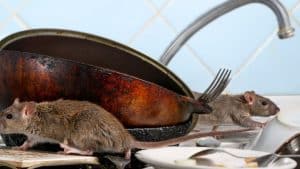Dealing with rodents in a building can be a stressful ordeal. Not only do they pose health risks by contaminating food and spreading diseases like salmonella, but they can also cause significant structural damage by gnawing on wood, electrical wires, and gas lines. Understanding how to effectively how to prevent and manage pest infestation and rodents in your building is crucial for maintaining a safe and healthy environment. This guide provides comprehensive strategies for rodent control, emphasizing the need for proactive measures to deter rodents and the importance of professional pest control services.
Identifying and Eliminating Entry Points
One of the first steps in rodent prevention is to identify and seal potential entry points. Rodents can enter through holes as small as a dime, so it’s essential to inspect the building thoroughly. Common areas to check include gaps around doors, windows, and where utility lines enter the building. Sealing these gaps with materials like steel wool, metal plates, or weather stripping can significantly reduce the likelihood of rodents entering your home or business.
Use of Bait Stations and Traps
Implementing bait stations and traps strategically around your house and property can help control rodent populations. It’s important to place these tools in areas where rodent activity has been observed, such as near garbage storage, wood, areas, attics, and basements. Regular monitoring and maintenance of these stations will ensure they remain effective in capturing and eliminating rodents.
Proper Food Storage and Disposal
Rodents are primarily attracted to buildings in search of food. To deter how to prevent and manage rodents in your building, store food items, especially grains, meat and pet food, in metal or glass containers with tight-fitting lids. This prevents rodents from smelling and accessing the food. Additionally, managing garbage efficiently by using receptacles with secure lids and disposing of waste regularly can minimize the food sources available to rodents, reducing their incentive to enter your building.
Regular Inspection and Maintenance
Regular inspections are vital to prevent rodent infestations. Frequently check for signs of a rodent infestation or activity, such as droppings, nests, or gnawed materials. Pay special attention to areas like kitchens, storage rooms, and anywhere food is handled or stored. Regular maintenance tasks, such as cleaning up spilled food immediately and keeping dining and kitchen areas tidy, can also help prevent rodents from settling in.
For more thorough and effective rodent management and rat only, it’s advisable to engage professional pest control operators. They have the expertise to assess the extent of a rodent problem, implement effective control measures, and monitor the whole rat situation to prevent future rat infestations.
Call Safe Pest Control on 1300119085 to control and eliminate the problem safely before it turns into an infestation.
Strategic Use of Rodent Repellents and Barriers
To further enhance your rodent control efforts and contaminate food elsewhere, consider the use of repellents, chemicals and physical barriers. Repellents can deter rodents from entering specific areas of your building to contaminate food there. Natural options such as peppermint oil are popular, though their effectiveness can vary and they often require frequent reapplication. Physical barriers, such as metal or glass containers for food storage, not only prevent contamination but also block access to any potential food sources.
Managing Outdoor Environment
The area surrounding your building can also influence rodent and mice nest infestations too. Reduce nesting sites by keeping yards clean and free of debris where rodents and cats could hide or build nests. Ensure that shrubbery and tree branches are trimmed back from the building to eliminate pathways onto the property. Additionally, consider installing grates on floor drains and vents to prevent rats and mice from entering through these access points.
Collaborating with Pest Control Professionals
While DIY methods can be effective, collaborating with professional pest control operators offers additional assurance. These professionals can provide a comprehensive evaluation of pest and rodent infestation, on your property, identifying not just the obvious signs of rodent activity but also the less noticeable vulnerabilities. Pest control experts use a variety of methods to manage rodent populations, including advanced baiting techniques and long-term deterrent strategies.
Professional services also ensure that any measures taken against rats are safe and humane, keeping both the occupants of the house or building and the environment in mind. Regular follow-ups by these experts can help to adjust strategies as needed and provide ongoing protection against rodents.
Remember to Call Safe Pest Control Sydney on 1300119085 for expert help in managing mice and eliminating rodents safely and effectively.

Enhanced Building Maintenance for Effective Rodent Control
Maintaining the structural integrity of your building is essential in the fight against rodent infestations. Rodents, common pests such insects such as mice and rats, can exploit even the smallest vulnerabilities in a building’s exterior to gain access. Regular and thorough maintenance checks are critical to ensure that these potential entry points are identified and sealed promptly.
Routine Structural Inspections
The cornerstone of preventing rodents from entering is to conduct routine inspections of the building’s exterior. Pay special attention to the foundation, walls, and roofing, as these are common areas where rodents may find entry points. It’s important to look for any signs of deterioration, such as cracks, holes, or unsealed gaps. These inspections should be carried out at least biannually, or more frequently in older buildings or those in areas prone to rodent problems.
Repair and Reinforcement Techniques
Upon identifying potential entry points, immediate action to repair and reinforce these areas is necessary. For small cracks and holes, heavy-duty sealants can be effective. These sealants not only block the holes but also resist gnawing and chewing by rodents, offering a long-term solution to serious problems. For larger breaches, particularly those in foundations or around utility entries, more robust materials such as concrete or metal flashings should be used. Metal flashings are especially useful in areas prone to gnawing, as they are impervious to the sharp teeth of rodents and snakes.
Roofing Vulnerabilities
Roofing is another critical area that should be carefully maintained. Gaps under roof tiles or between roofing materials can provide easy access for rodents. Ensuring that these holes are properly sealed with appropriate roofing cement or flashing can prevent entry from the ground or above ground above, which is a common but often overlooked route for rodents.
Securing Vents and Chimneys
Vents in attic and chimneys are also potential entry points for rodents. Installing screens or vent covers made from durable materials like metal can prevent rodents from entering the attic while still allowing for proper ventilation. It’s important that these covers are maintained and checked regularly for signs of rust or damage, which could compromise their effectiveness.
Window and Door Frames
Finally, windows and doors should be inspected for gaps or holes around the frames. Weather stripping and door sweeps can be installed to seal these holes and gaps, preventing rodents from squeezing through. Ensure that these materials are of good quality and check them regularly for wear and tear, replacing them as necessary to maintain a tight seal.

Conclusion on Building Maintenance for Rodent Control
Enhanced building maintenance is a proactive approach to rodent control. By systematically inspecting, repairing, and reinforcing the structural integrity of your building, you can significantly reduce the risk of rodent infestations. Remember, the goal is to prevent mice and to make your building less inviting to rodents by eliminating their potential pathways inside. This, combined with other rodent prevention strategies, will both prevent mice and help maintain a safe and healthy environment for all building occupants.
Interior Maintenance Checks
Inside the building, maintain vigilance in areas prone to moisture and clutter, which can attract rodents seeking a habitat. Ensure that attics, basements, and utility rooms are dry and well-ventilated. Reducing humidity and removing clutter diminish the attractiveness of these spaces to rodents looking for nesting sites. Regularly inspecting and clearing out storage areas also helps minimize potential nesting materials, such as soft materials and insulation.
Engaging Tenants and Employees in Rodent Prevention
Rodent control is a community effort. Engaging everyone in your business or building in the fight against rodents enhances the effectiveness of your prevention strategies. Educate tenants and employees about the importance of keeping work and living spaces neat and storing food properly. Encourage the prompt reporting of any signs of rodent activity, such as droppings, nests, or sightings by pets, which can allow for quicker response and control measures.
Scheduled Cleanings and Waste Management
Implementing a regular cleaning schedule and effective waste management practices are crucial. Ensure that food waste is disposed of promptly in sealed containers and that the garbage collection areas are clean and free from debris. Regular cleaning helps reduce food particles and residues that attract rodents rats and cats, further safeguarding your building from infestations of mice.
Safeguarding Your Building Against Rodents
Rodents pose significant risks to humans and buildings, from health hazards associated with their presence to the physical damage they cause. By implementing a robust rodent control strategy that includes sealing off entry points, maintaining cleanliness, managing outdoor environments, and utilizing professional pest control services, you can significantly reduce the risk and likelihood of an a rodent infestation.
For specialized assistance and to ensure your business or property is protected from rodents, remember to call Safe Pest Control at 1300119085. Take action today to prevent, kill and keep pests, manage rodents effectively and maintain a safe, healthy environment for everyone in your building.

FAQs on Rodent Control
What is the best practice for rodent control?
The best practice for rodent control involves a combination of exclusion, sanitation, and population control. Firstly, seal all potential entry points with materials like steel wool and metal plates to prevent access. Maintain cleanliness in all areas, especially where pet food is stored and disposed of, to eliminate attractants. Lastly, use traps and bait stations strategically placed around the property to manage the rodent population effectively. Regularly inspect these measures to ensure they remain effective and adapt strategies as necessary.
How can we prevent and control rodents?
Preventing and controlling rodents can be achieved by maintaining a clean environment, storing food securely, and eliminating entry points. Regularly inspect your building for signs of rodents, such as droppings or gnaw marks, and respond promptly to these indicators. Store all food, including pet food and animal feed, in sealed glass or metal containers. Engage a professional pest control service to implement a tailored and comprehensive rodent management plan.
What are the four steps in controlling rodents?
-
Inspection: Regularly check your property for signs of rodents, identify potential entry points, and assess the extent of any infestation.
-
Prevention: Seal off entry points using durable materials, manage waste effectively, and store food in rodent-proof containers.
-
Control: Set up traps or bait stations in areas where rodent activity is noted. Consider the safe use of rodenticides if necessary.
-
Monitoring: Keep an ongoing check on rodent control measures and adjust as needed. Regular follow-ups with pest control professionals can help ensure that the methods remain effective.
How to prevent rodents in a house?
To prevent rodents in a house, seal all holes and gaps in exterior walls, foundations, and around doors and windows. Use steel wool and caulk for smaller gaps and consider installing door sweeps to block entry under doors. Manage garbage and food storage carefully, using containers that rodents cannot easily penetrate. Regular housekeeping can also deter rodents by reducing the food particles and clutter that attract them.
On-Time Service

5 STAR SERVICE BASED ON 100+ GOOGLE REVIEWS
PET & FAMILY FRIENDLY TREATMENT

ALL YEAR-ROUND PROTECTION
Take Back Control Now
8
REASON TO CHOOSE SAFE PEST CONTROL
- Guarantee protection all year-round
- 30 Years Collective Experience
- An impeccable reputation across Sydney's Suburbs
- Certified treatments & written Warranty On all work carried out
- Family Owned & Operated
- Rated #1 Pest Control In Sydney NSW
- No Mess, No Smell
- Family & Pet Friendly Treatments
REQUEST A QUOTE






